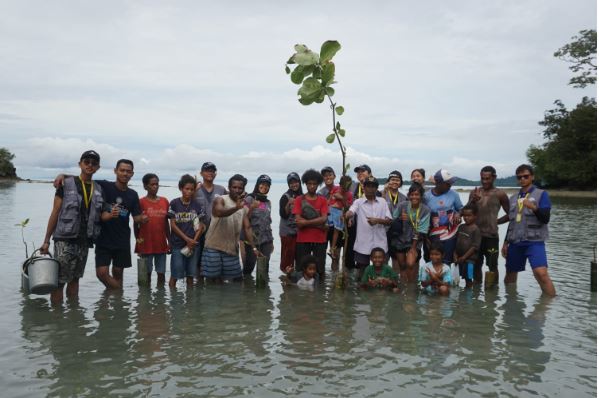
UGM students taking the Community Service Program (KKN-PPM) in Raja Ampat Regency, Southwest Papua Province, Indonesia, carried out several monumental programs.
Apart from planting 100 mangrove trees along the coastal area of Teluk Mayalibit District, Raja Ampat Regency, they also hoisted the Indonesian flag underwater to commemorate the 78th Independence Day of Indonesia.
Additionally, they organized the Teluk Mayalibit Cultural Festival with the theme “Sa Papua, Sa Cinta Budaya.”
For the mangrove planting activity, the students worked in two areas, namely Warsambin and Mumes Villages, working alongside the local community and relevant government agencies, such as the Environmental and Forestry Agency.
The activity aimed to preserve and optimize the utilization of local natural resources in the Teluk Mayalibit area.
The goal was to enhance the ecosystem between the coastal and marine areas of Mumes and Warsambin Villages, both of which were considered to have significant tourism potential.
“This planting is an effort to preserve mangroves in Warsambin Village, where the number of mangroves has been decreasing,” said Jihan, PIC for the mangrove planting program in the Warsambin sub-unit.
“We hope that planting these mangrove trees will attract more tourists and ensure benefits for future generations.”
Before the planting activity, some team members had to participate directly to learn about planting and obtain mangrove seedlings on Friwen Island, South Waigeo.
This was because the community on Friwen Island had already partnered with the Peat and Mangrove Restoration Agency and the Ministry of Environment and Forestry in mangrove preservation activities.
“To obtain 100 mangrove seedlings, the UGM team must travel by motorboat across the sea for approximately 2-3 hours. The availability of 100 mangrove seedlings on Friwen Island resulted from the collaboration between students and the Mangrove Farmer Group of Friwen Village,” she explained.
Additionally, the hoisting of the Indonesian flag underwater in Raja Ampat was the first time that the students commemorated Indonesia’s Independence Day in such a manner.
“I believe this experience will be unforgettable, and I’m grateful to have participated in the flag hoisting and diving in Raja Ampat’s waters,” said team member Salma.
Salma explained that the flag hoisting occurred on Friday (August 4). The activity began with a journey from Mumes Village to Waisai and a longboat trip to Saonek Island. The underwater flag hoisting was conducted in the late afternoon, accompanied by Rudi, a local dive master in Raja Ampat.
Salma added that the flag hoisting went smoothly despite strong currents underwater. The UGM team also took a brief, fun dive, encountering various marine animals and plants during the hoisting.
“There were sea anemones, hard and soft coral, marine animals, and some schooling fish. Unfortunately, we couldn’t hoist the flag or dive for long due to the approaching evening and the increasing strength of the currents,” Salma explained.
As their 50-day community service in Teluk Mayalibit District concluded, the UGM students organized the Teluk Mayalibit Cultural Festival with the theme “Sa Papua, Sa Cinta Budaya.”
The festival aimed to revive cultural practices lost within the Raja Ampat community. This revival focused particularly on Papua’s traditional dance culture.
The festival featured dance performances from four major villages in Teluk Mayalibit District: Warsambin, Mumes, Lapintol, and Kali Tokodan Villages. The celebration began with a parade of children dressed in traditional Papuan attire, accompanied by local youth playing the flute and drum.
The festival was attended and inaugurated by the Deputy Regent of Raja Ampat, Orideko Burdam, who struck the tifa and sounded the triton. The deputy regent commended the students’ initiative to revive cultural practices and traditions within the community.
“The development of Raja Ampat is rooted in a strong cultural and traditional foundation. This includes harnessing local potential and wisdom, such as cultural traditions, to address challenges in the tourism industry,” Orideko Burdam.
“It’s not just about the natural beauty but also the creativity and hospitality of the people of Raja Ampat.”
The festival showcased original dances of the local population (Maya Tribe) and Papuan dances, such as Yosim Pancar, Pangkur Sagu, and Tumbello. It concluded with the Yosim Pancar dance, in which the deputy regent and the community joined in the dance.
“We all hope this cultural festival will serve as the gateway to the return of Raja Ampat’s cultural heritage,” expressed Orideko Burdam.
Author: Agung Nugroho

